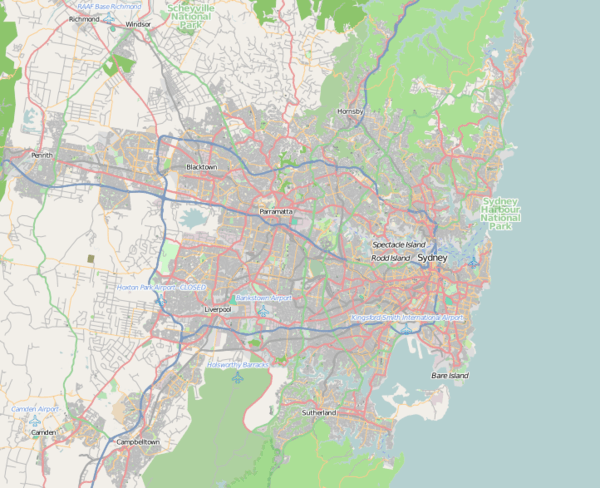Dawes Point Battery
| Dawes Point Battery | |
|---|---|
| Dawes Point, Sydney | |
 Dawes Point Battery | |
 Dawes Point Battery | |
| Coordinates | 33°51′18″S 151°12′34″E / 33.854945°S 151.209404°E |
| Type | Gun Battery |
| Site information | |
| Condition | Demolished between 1925 and 1932 |
| Site history | |
| Built | 1791 |
| Materials | Sandstone |
The Dawes Point Battery is an historical fortification that was located adjacent to the southern pylon of the Sydney Harbour Bridge at Dawes Point, New South Wales, Australia.[1]
History
The first known building to be constructed on the site of Point Maskelyne (later renamed Dawes Point) was an observatory constructed in early 1788 by Lieutenant William Dawes.[2]
A powder magazine was installed in 1789 followed by the Battery in 1791. The first guns came from HMS Sirius, which had wrecked at Norfolk Island the year before. A dispute in 1790 between Spain and Britain, leading to fear of a Spanish attack, motivated the project.
In 1798, the Governor's concerns regarding the arrival of schooner Argo prompted defensive measures at the Battery.[3] George Barney, one of Australia’s most important colonial engineers of the mid-19th century, oversaw the construction. The site had previously been used as a cemetery for prisoners executed at Sydney Gaol (1797-c1830).
In 1810 Napoleon ordered the French forces at Île de France to launch an attack on Sydney. However, but the Royal Navy captured the island, forestalling any attack. During the Napoleonic War French and Spanish ships captured in the Pacific Ocean and brought into Sydney harbour received salutes from the battery.
The fort was expanded substantially in 1819 when Governor Lachlan Macquarie ordered convict Francis Greenway, who was an architect, to design and construct improvements. The result was a semicircular battery, supported by a new, decorative castellated guardhouse built on the site of the 1780 powder magazine, which now provided the guardhouse's basement. The elaborate defences were meant to appear threatening to ships sailing into Sydney Harbour. In that same year sandstone blocks were quarried on site at Dawes Point Park for the construction of the fort.[4]
The Aroostook War, a confrontation in 1838–1839 between the United States and the United Kingdom over the international boundary between the British colony of New Brunswick and the US state of Maine, raised concerns over the harbour's defenses. The arrival of two American sloops during the night, however peaceful, highlighted the colony's vulnerability.
The Russian success in repulsing an Anglo-French force in the Siege of Petropavlovsk, in the northern Pacific during the Crimean War (1854–56), raised concerns that Russian Pacific Fleet would attack Sydney. At the time New South Wales was undergoing an economic boom following the discovery of gold. The colonial government enlarged Fort Macquarie and Dawes Point, constructed further fortifications at Kirribilli and Mrs Macquarie's Chair, and finished Fort Denison. Dawes Point received additional subterranean powder magazines and the Royal Artillery provided a garrison. Dawes Point Battery also became the command post for the fortifications around the inner harbor.
Colonel George Barney was given the task renovating Sydney’s fortifications and an extension of Dawes Point in 1860.
Sydney’s Harbour defences had been relocated to the entrance of Port Jackson by the end of the 19th century, thus rendering Dawes Point obsolete. The battery was then used to store the Commandant of the Australian Military from 1901 and 1903.
Most of the fort was demolished in 1925 to make way for the construction of the Sydney Harbour Bridge. In 1932 the remaining buildings that served as a headquarters for Dorman and Long, the British company responsible for the construction of the Sydney Harbour Bridge were demolished and the whole area landscaped and set aside for public use.[5]
In 1995 archaeological investigations were carried out at the Battery site, and the findings were incorporated into a new interpretive park which was opened to the public in 2001. The park was named "Dawes Point|Tarra" acknowledging the Cadigal name for the area.[6]
Armaments
- 5 x 42-pounder cannons
References
- ↑ http://www.shfa.nsw.gov.au/uploads/documents/Dawes%20Point%20Excavation.pdf
- ↑ "The First Observatory in Parramatta". The Cumberland Argus And Fruitgrowers Advocate. XI, (698). New South Wales, Australia. 1 November 1899. p. 1. Retrieved 11 August 2018 – via National Library of Australia.
- ↑ Barrington, George (1810). The History of New South Wales, 2nd ed. London: Printed for M. Jones. pp. 238–239, 410–412.
- ↑ NSW Heritage Office Website - Online Database
- ↑ http://www.shfa.nsw.gov.au/sydney-Resource_Centre-Heritage_materials-Heritage_Register-Dawes_Point_Battery_remains.htm
- ↑ The Rocks: Dawes Point Battery https://www.therocks.com/dawes-point-battery-1790-1925-australia-s-first-permanent-defence-fortification/
External links
| Wikimedia Commons has media related to Dawes Point Battery. |
 Cannons at the Dawes Point "Tarra" interpretive park
Cannons at the Dawes Point "Tarra" interpretive park Cannons at the Dawes Point "Tarra" interpretive park
Cannons at the Dawes Point "Tarra" interpretive park Cannons at the Dawes Point "Tarra" interpretive park
Cannons at the Dawes Point "Tarra" interpretive park Cannons at the Dawes Point "Tarra" interpretive park
Cannons at the Dawes Point "Tarra" interpretive park.jpg) Point "Tarra" interpretive park
Point "Tarra" interpretive park